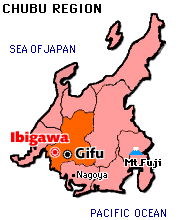 |
|
| Geographical location | |
Town of Ibigawa
Lat. 35° 29' N
Long. 136° 34' E
Access
from Tokyo
about 110 minutes by bullet train
to Nagoya station
from Nagoya station
about 52 minutes by train
from Osaka
about 38 minutes by bullet train
to Maibara sation
from Maibara
about 58 minutes by train
| |
Related links Gifu Prefecture Welcome to Gifu Gifu Prefectural Museum |

 At Ojima Elementary School in the town of
Ibigawa, they have some rather unusual pets--earthworms. At the edge of the school
grounds is a hut of about 6 square meters called the "Friendly Worm House." Several
tens of thousands of worms are kept in soil that is spread on the floor of the
hut with straw laid on top.
At Ojima Elementary School in the town of
Ibigawa, they have some rather unusual pets--earthworms. At the edge of the school
grounds is a hut of about 6 square meters called the "Friendly Worm House." Several
tens of thousands of worms are kept in soil that is spread on the floor of the
hut with straw laid on top. So, why worms? Worms generally have an image
as slimy creatures that live in the ground, but actually they play a very important
ecological role in the interaction between water, air, sunlight, and living creatures.
Worms eat rotting fallen leaves and turn them into tiny pellets of waste, which
make excellent fertilizer for plants. By moving around in the earth, they also
perform the task of plowing the soil.
So, why worms? Worms generally have an image
as slimy creatures that live in the ground, but actually they play a very important
ecological role in the interaction between water, air, sunlight, and living creatures.
Worms eat rotting fallen leaves and turn them into tiny pellets of waste, which
make excellent fertilizer for plants. By moving around in the earth, they also
perform the task of plowing the soil.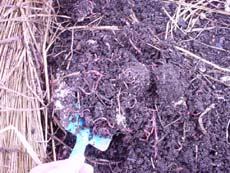 Ojima Elementary School's plan to keep worms
was inspired by the idea that they could be used to process organic waste. Household
organic garbage like vegetable waste and fruit skins is usually burned in incinerators
at waste-processing plants, but because the waste contains water, burning it takes
a lot of time and money and also produces a lot of carbon dioxide, which causes
global warming.
Ojima Elementary School's plan to keep worms
was inspired by the idea that they could be used to process organic waste. Household
organic garbage like vegetable waste and fruit skins is usually burned in incinerators
at waste-processing plants, but because the waste contains water, burning it takes
a lot of time and money and also produces a lot of carbon dioxide, which causes
global warming. The school thought that turning organic
waste into soil without burning would be a good way to cut down on global warming
and would be ideal for the ecosystem.
The school thought that turning organic
waste into soil without burning would be a good way to cut down on global warming
and would be ideal for the ecosystem.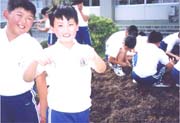 It was the existence of earthworms that
allowed the school to realize its dream. If you feed organic waste to a group
of worms that have bred over a certain density, they can process the waste overnight.
This means the kids can watch food being turned into soil before their very eyes.
It was the existence of earthworms that
allowed the school to realize its dream. If you feed organic waste to a group
of worms that have bred over a certain density, they can process the waste overnight.
This means the kids can watch food being turned into soil before their very eyes.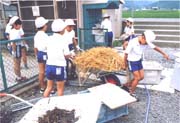 The
first stage of the "Worm Friendship Plan" was the collection of worms. In 1999
sixth graders and fathers of Ojima students collected about 500 worms. They put
soil into the Worm House, then the kids cared for the worms by watering and scattering
rice bran (empty shells of rice grains) on the soil. It has been two years since
the plan began, and there are now several hundred times more worms than at the
start. They live mainly off leftover food from the rabbits the school keeps and
by processing fallen leaves.
The
first stage of the "Worm Friendship Plan" was the collection of worms. In 1999
sixth graders and fathers of Ojima students collected about 500 worms. They put
soil into the Worm House, then the kids cared for the worms by watering and scattering
rice bran (empty shells of rice grains) on the soil. It has been two years since
the plan began, and there are now several hundred times more worms than at the
start. They live mainly off leftover food from the rabbits the school keeps and
by processing fallen leaves. Fourth grader Yuki Endo says, "If we
put in some leftovers from our lunches, sometimes they're all gone by the next
day. Worms eat a lot and turn their food into soil that is good for plants! I
think that's what our teacher means by using worms to recycle stuff."
Fourth grader Yuki Endo says, "If we
put in some leftovers from our lunches, sometimes they're all gone by the next
day. Worms eat a lot and turn their food into soil that is good for plants! I
think that's what our teacher means by using worms to recycle stuff."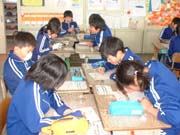 "I
wanted to know more about worms, so I watched them. When I see how their bodies
and their mouths move, and how they produce waste, I think they look cute,"
adds fourth grader Hiroko Kubota. When they started, the kids didn't know much
about worms. Now the worms have become important friends for them.
"I
wanted to know more about worms, so I watched them. When I see how their bodies
and their mouths move, and how they produce waste, I think they look cute,"
adds fourth grader Hiroko Kubota. When they started, the kids didn't know much
about worms. Now the worms have become important friends for them.